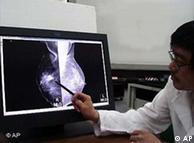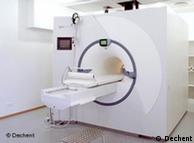一種認為多吃蔬果可以"預防或治療"乳癌的說法
沒根據
No Cancer Shield Found in Fruit and Vegetable Diet
Hopes that a diet low in fat and full of fruits and vegetables could prevent the return of breast cancer were dashed Tuesday by a large seven-year experiment in more than 3,000 women.
The government study found no benefit from a diet that included far more than the recommended servings of five fruits and vegetables a day.
The study appears in Wednesday's Journal of the American Medical Association.
''It sends us back to the drawing board,'' said Susan M. Gapstur of the Feinberg School of Medicine at Northwestern University, who was not involved in the new study but was a writer of an accompanying editorial in The Journal.
''Should we really have focused on dietary components like fruits, vegetables and fat?'' Dr. Gapstur asked. ''Or should we be focusing, in addition to diet, on lifestyle factors including physical activity and weight?''
For now, the message for the 2.4 million breast cancer survivors in the United States is that they do not need to go overboard on vegetables, researchers said.
Earlier research on whether a healthy diet prevents breast cancer has shown mixed results. The new study was designed to be more rigorous.
In this experiment, all the women had been successfully treated for early stage breast cancer. Their average age was 53 when the study began.
A group of 1,537 women were randomly assigned to a daily diet that included five vegetable servings, three fruit servings, 16 ounces of vegetable juice and 30 grams of fiber. In most cases, a serving equaled a half cup. French fries and iceberg lettuce could not be counted as vegetables.
The women were allowed to eat meat, but were told to get no more than 15 percent to 20 percent of their calories from fat.
As a comparison, an additional 1,551 women were assigned to get educational materials about the importance of eating five servings of fruits and vegetables a day.
During the next seven years, the cancer returned in about the same proportion of women in both groups. About 10 percent of both groups died during that time, most of them from breast cancer.
科学 | 2007.08.13
磁共振成像能更早更准发现乳腺癌
在德国常用于乳腺癌早期诊断的主要是X光检查,但是根据波恩大学教授克里斯蒂安娜•库尔的最新研究结果,利用核磁共振成像(德语简称MRT)可以更准确地 发现癌细胞,尤其是在早期。这能不能成为广大女性的福音还很难说,因为磁共振检查的成本、技术要求都更高,要真正推广到医疗实践中还有待时日。德国之声中 文网综合报道如下:
磁共振成像在乳癌早期检查上运用过少
据估算,德国每年都有4.4万女性患上乳癌。这 种疾病已经成为危害女性生命健康的主要杀手之一。波恩大学放射诊所以库尔教授为主的专家组进行了五年的调查研究,得出了一个颠覆性的结论:目前常用的X光 检查发现乳腺癌的准确诊断率远远低于核磁共振成像。五年来,在来到波恩大学放射所作乳腺癌早期检查和诊断的7300多名女性中,有167名女性被确诊为乳 腺癌早期,也就是说,癌细胞还停留在乳腺而没有扩散到血管和淋巴管。其中采用磁共振成像的诊断准确率是92%,而用X光诊断准确率却只有56%。
这项研究成果上周六发表在英国医学杂志《柳叶刀 (The Lancet)》第370期,它推翻了医学界以往认为磁共振成像不适合用于乳癌早期检查的观点。库尔教授在接受德新社记者采访时解释道,癌细胞通常最早产 生于乳腺管内壁,在这个时期它还可以算作是良性癌病变,因为还没有扩散到血管和淋巴管中,如果能够及早发现并通过手术取出癌组织,那么就可以避免其发展成 为“真正的”扩散性乳癌。所以在早期阶段发现的乳腺癌一般都是可以治愈的。而这些早期的癌细胞,因为有些还没有钙化,所以用X光检查是发现不了的,在这方 面磁共振成像技术就显示出优势了。 Bildunterschrift: Großansicht des Bildes mit der Bildunterschrift: X射线检查只能诊断出一半的早期乳腺癌
Bildunterschrift: Großansicht des Bildes mit der Bildunterschrift: X射线检查只能诊断出一半的早期乳腺癌
谁来掏钱?——短时间内难以推广
这种早期检查技术虽然准确率高,可以提高乳癌的 治愈率,但是从实践的角度看却很难推广。库尔教授推荐,X光照射作为基础性的早期检查还是不能放弃的,因为一次磁共振检查要花600多欧元,价格是X光检 查的近十倍,医疗保险公司很少会愿意支付这笔费用。这意味着,如果想及早准确发现乳腺癌,就必须自己掏一大笔钱去找专门的医生做磁共振检查。
而且,磁共振成像技术操作比较复杂,目前还不被 大多数放射科医师所掌握。海德堡德国癌症研究中心的施特凡·德罗姆在接受“明镜在线”记者采访时说:“要想在乳腺癌早期检查上推广磁共振成像,既缺专家, 又缺仪器。”同时他还提醒,不能忽视核磁共振成像技术对人体造成的风险。根据调查,1.5%的人对检查时涂抹的造影剂有过敏等不良反应。
库尔教授说:“我们的研究成果当然要首先接受医学同仁各种不同意见的检验——在科学研究上一直都是这样——才能拥有更广泛的基础。”
磁共振成像技术运用磁场和高频率电磁波来绘制成人体内部结构图像;而X光检查运用的是放射线照相技术来进行骨骼和软组织的诊断,但对某些病变的可见程度有限。

1 則留言:
蘋果或許真無益健康﹐但以霍桑效應之說﹐當您開始很關心自己的健康﹐健康已經開始好轉了。因此﹐蔬果﹑運動﹑養生﹑氣功等﹐都可根據自己喜好選擇!
張貼留言